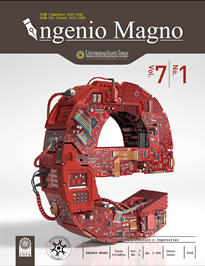Final automated welding processes for GM colmotores passenger vehicles
Main Article Content
Abstract
Downloads
Article Details
DECLARATION OF ORGINIALITY OF SUBMITTED ARTICLE
With this document, I/We certify that the article submitted for possible publication in the institutional journal INGENIO MAGNO of the Research Center Alberto Magno CIIAM of the University Santo Tomás, Tunja campus, is entirely of my(our) own writing, and is a product of my(our) direct intellectual contribution to knowledge.
All data and references to completed publications are duly identified with their respective bibliographical entries and in the citations thus highlighted. If any adjustment or correction is needed, I(we) will contact the journal authorities in advance.
Due to that stated above, I(we) declare that the entirety of the submitted material is in accordance with applicable laws regarding intellectual and industrial property, and therefore, I(we) hold myself(ourselves) responsible for any complaint related to it.
If the submitted article is published, I(we) declare that I(we) fully relinquish publishing rights of the article to the University Santo Tomás, Tunja campus. As remuneration for this relinquishment of rights, I(we) declare my(our) agreement to receive two (2) copies of the edition of the journal in which my(our) article appears.
References
Berglunda, A. F., Fässberg, T., Hellman, F., Davidsson, A. y Stahre, J. (2013). Relations between complexity, quality and cognitive automation in mixed-model assembly. Journal of Manufacturing Systems, 33(3), 49-455.
Córdoba, E. (2006). Manufactura y automatización. Revista Ingeniería e Investigación, 26(3), 120-128.
Chou, W., You, L. y Wang, T. (2006). Automatic path planning for welding robot based on reconstructed surface model. Robotic Welding, Intelligence and Automation, 362, 153-161.
GM Colmotores Medios (2014, 4 de septiembre). Equipo de Manofactura de GM Colmotores recibe reconocimiento global por plan de automatizaciones de bajo costo. Recuperado de http://media.gm.com/media/co/es/chevrolet/home.detail.html/content/Pages/news/co/es/2014/sept/0904-equipo.html
Gu, Z. R., Zue, L. W., Wei, J. H. y You, B. (2000). The working path panning of welding robot of hydraulic turbine runners. Journal of Harbin University of Science and Technology, 6.
Gorlach, I. y Wessel, O. (2008). Optimal level of automation in the automotive. Engineering Letters, 16(1).
Hong, T. S., Ghobakhloo, M. y Khaksar, W. (2014). Robotic welding technology. En S. Hashmi et al. (Eds), Comprehensive Materials Processing (pp. 10-17). Oxford: Elsevier.
Kalpakjian, S. y Schmid, S. R. (2002). Manufactura, ingeniería y tecnología. Ciudad de México: Pearson. Kumar, R. y Garg, R. K. (2010). Optimal selection of robots by using distance based approach method. Robotics and Computer-Integrated Manufacturing, 26(5), 500-506.
Michalos, G., Makris, S., Papakostas, N., Mourtzis, D. y Chryssolouris, G. (2010). Automotive assembly technologies review: challenges and outlook for a flexible and adaptive approach. Journal of Manufacturing Science and Technology, 2(2), pp.81-91.
Pan, Z., Polden, J., Larkin, N. y Van, S. (2012). Recent progress on programming methods for industrial robots. Robotics and Computer Integrated Manufacturing, 28 (2), 87-94.
Rico, M. J., Sánchez, C. M. y Laverde, R. (2012). Sector automotor colombiano: innovar para crecer. Revista ANDI, 234, 10-17.
Rivera, S. (2011). Documento resumen Proyecto de Automatización en Procesos de Pintura y Soldadura. Bogotá: General Motors.
Sung, B., Kim, I., Xue, Y., Kim, H. y Cha, Y. (2007). Fuzzy regression model to predict the bead geometry in the robotic welding process. Acta Metallurgica Sinica, 20(6), 391-397.
Trnka, K. y Bozek, P. (2013). Optimal motion planning of spot welding robot applications. Applied Mechanics and Materials, 248, 589-593.
Wang, J. H., Xiao, R. H. y Ma, Y. L. (2011). Research on welding robot path panning using ant colony optimization. Advanced Manufacturing Systems, 201, 1926-1929.
Wu, Y. Q., Yuan, Z. H. y Wang, J. H. (2012). A fuzzy controller design of seam tracking for welding robot. En 23rd International Conference on Industrial Electronics, Control and Instrumentation (pp. 1367-1372). Doi: 10.1109/IECON.1997.668515
Xu, D., Wang, L. y Tan, M. (2004). Image processing and visual control method for arc welding robot. En IEEE International Conference on Robotics and Biomimetics (ROBIO) (pp. 727-732). Doi: 10.1109/ROBIO.2004.1521871
Yang, X. (2011). Key technology research on the flexible welding line for multi-model automobile. En Second International Conference on Digital Manufacturing and Automation (ICDMA 2011). Doi: 10.1109/ ICDMA.2011.169
Yue, H., Li, K., Zhao, H. y Zang, Y (2006). Vision-based pipeline girth-welding robot and image processing of weld seam. Industrial Robot: An International Journal, 36(3), 284-289.

